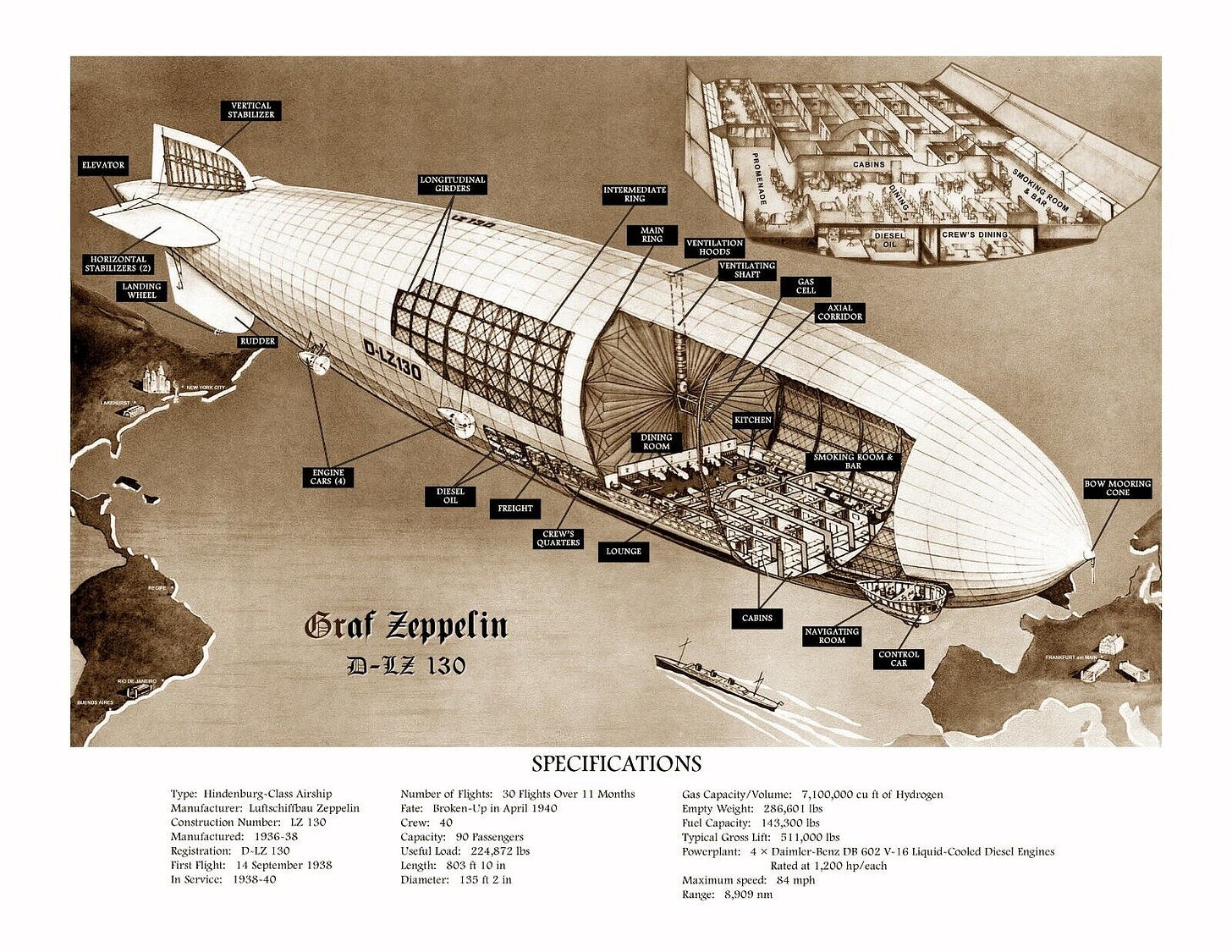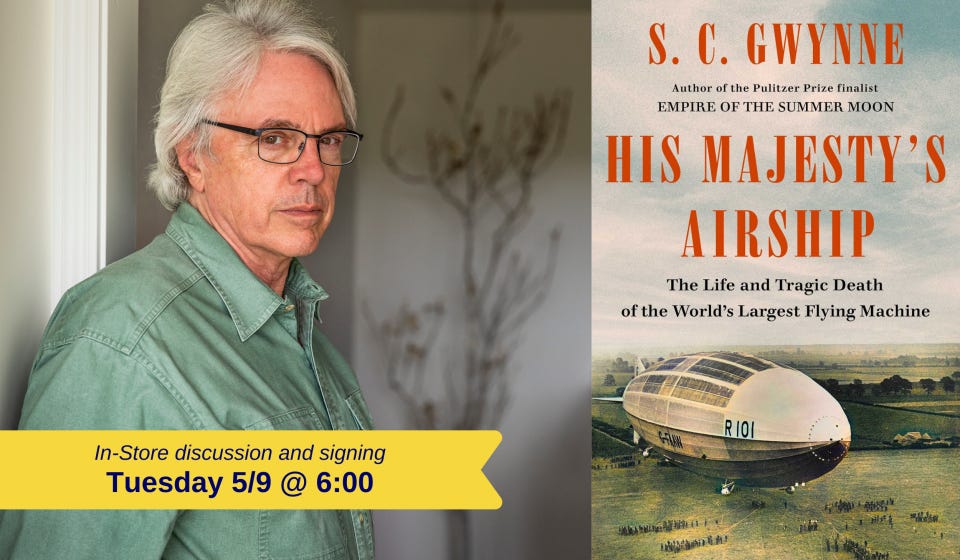A Tale of Human Folly and Mass Destruction
How S.C. Gwynne's new book about airships shows how dumb smart people can be
Several times a year, I get up before the sun and meet my friend Sam at the south end of the Pflueger Pedestrian Bridge in downtown Austin to walk around Lady Bird Lake and set the world to rights. We have a setlist of topics: the censorious left, the fascist-adjacent right, his career in magazines and books, mine in public service, the frustrating absurdism of both, and what we’re working on. And because Sam is better known as S.C. Gwynne, the guy who wrote Empire of the Summer Moon as well as my favorite books on Stonewall Jackson and football, I confided in him when I was struggling with Forget the Alamo. And he told me what he was up to when he started on his latest book, His Majesty’s Airship: The Life and Tragic Death of the World’s Largest Flying Machine, but at first I didn’t get it.
“You’re writing about blimps?” I asked, suddenly concerned for his career.
“No, ‘rigid airships,’” he corrected, waving his right index finger. Blimps are just big balloons with baskets at the bottom. Rigid airships are zeppelins, bigger than the Titanic made lighter than air because their metal frames held giant bags of hydrogen. More than a hundred years ago, few imagined that airplanes, which were noisy, unpressurized, and required frequent refueling, would ever be practical for long-range travel. If they could ever get past what Gwynne winningly describes as the “growing pains” of this new technology, airships could reduce a journey of weeks into a few days.
“So like the Hindenburg?”
“Yes, but…” and then Sam and his right index finger were off again, saying that’s a small part of this huge story that we’ve all forgotten today because, well, look around you. Or rather, look up: airplanes, drones, hot air balloons, even a Goodyear blimp now and again, but nary a zeppelin in sight. If you’re telling me there used to be a competition between airplanes and the Hidenburg, I’m pretty sure I don’t need to read a book to find out who won. I remained concerned for his career.
I shouldn’t have.
Let’s go back to World War I to explain why I’m a fan of what Sam brought to this book. In 1914, Germany, using zeppelins as the first bombers, “introduced to humankind the notion that it could be annihilated from the sky by something other than a thunderbolt.” They were, Sam writes, “the world’s first weapons of mass terror.” Germany made them, Britain didn’t, and for that matter had no way of defending against them. Winston Churchill, then the First Lord of the Admiralty (which sounds super fancy), warned that Britain “was quite powerless to prevent such an attack.”
“the world’s first weapons of mass terror”
The raids on London began in 1915. German newspapers were filled with the exploits of these zeppelins, approvingly called “baby killers,” that killed thousands on each raid, crippling factories and leaving cities in flames. It was big news that a million British troops were needed to defend against the attacks, because every British soldier called back to defend Mother England from these flying German monsters was one more boy not shooting at their sons on the Western front. Zeppelins were turning the war in their favor, crippling England’s capacity and will to fight by killing thousands of civilians in their sleep on a nightly basis. Germans ate this up with a spoon.
“The problem with such German claims,” writes Sam, “is that they were not true.”
In these pre-GPS days, the zeppelin crews really had no idea where they were going or what they were hitting. One crew thought it was following the Thames and that it had struck London when in fact it hit a swamp 60 miles from London. Another demolished a pub in Tipton and killed some farm animals. “So many bombs fell in fields that the British began to believe that the zeppelins were deliberately attacking crops and livestock,” writes Sam, who allows that some of the false reports were due to wrong-headed zeppelin commanders who honestly mistook a farm for a factory.
“So many bombs fell in fields that the British began to believe that the zeppelins were deliberately attacking crops and livestock”
But the reports from the raids were uniformly successful, hyped by credulous military press agents to journalists and then to ze Germans, and it wasn’t just the people. Encouraged by their “successes,” Germany ramped up zeppelin production until British airmen learned that if you shot one of those suckers with a phosphorus round it made a big, pretty boom. Of the 125 zeppelins Germany flew during the war, 46 were shot down, eight were destroyed by storms (they were really fragile), 15 blew up in their hangars (they went all explody a lot), 12 wrecked in forced landings (these were not easy to fly), 32 just kinda broke apart and had to be scrapped (getting the picture?), and the last 12 were given to the Allies after the war as reparations.
The Germans’ problem was obvious. Writes Sam, “the German government never stopped believing its own disinformation.” Humans’ capacity to create a false narrative, believe it, and then act as if the lie is true is one of my favorite ways brains are stupid. This flavor of human folly is sadly common and explains why we invaded Iraq. It’s why a Republican member of congress is rewarded and not exiled for introducing legislation to ban what doesn’t exist and punish what doesn’t happen.
“The German government never stopped believing its own disinformation”
But the Allies willful abandonment of reason in wanting the reaming dozen useless machines as their own to jumpstart their own airship programs speaks to the dangers of optimism in brainy, ambitious people who look at a disaster and think, “Yeah, but I could make that work.”
Turns out, Britain could not make airships work, and for that matter neither could France or the United States. The tale of His Majesty’s Airship does not suffer from ruining the ending in the book jacket: The airship whose final journey provide’s the book’s narrative blows up, and everyone dies. This is not a story about whether or not they made it. This is a story about why they tried in the first place and why country after country thought they would be the one to make a fallible, not to mention flammable, technology work.
And as fun as it is to point and laugh at First Lord Admiral of Explodington, Sam’s is a story of human folly, and in that it’s a story about how we’re all just one bad day away from winning a Darwin Award. His Majesty’s Airship comes out Tuesday, May 2, by which time he’ll be on a full-on book tour. Check your inbox Tuesday morning for an excerpt. It’ll be the first chapter called “Dreams, Pipe Dreams, and Imperial Visions.” If you’re in Dallas come join me at Interabang Books to hear his version of the story on May 9 at 6pm.
Dallas Morning News on SCG’s May 9 appearance
Jason Stanford is the co-author of NYT-best selling Forget the Alamo: The Rise and Fall of an American Myth. His bylines have appeared in the Washington Post, Time, and Texas Monthly, among others. Follow him on Twitter @JasStanford.
Further Reading
I’ve been writing this newsletter going on five years now. Inevitably, I find I’m retracing my steps. When that happens, I’ll repost older essays here.
We set up a merch table in the back where you can get T-shirts, coffee mugs, and even tote bags now. Show the world that you’re part of The Experiment.
We’ve also got a tip jar, and I promise to waste every cent you give me on having fun, because writing this newsletter for you is how I have fun.
Buy the book Texas Lt. Gov. Dan Patrick banned from the Bullock Texas History Museum: Forget the Alamo: The Rise and Fall of the American Myth by Bryan Burrough, Chris Tomlinson, and myself is out from Penguin Random House. The New York Times bestseller is 44% off and the same price as a paperback now!









I recently listened to the audiobook version of Sam’s book and I loved it so much but I purchased a hard cover copy. I’ve been really enjoying learning the history of airships lately and hope to share more of these details on my own publication in future months.
Wonderful! Thanks for sharing about Sam's new book. I just bought it.